The Best Deals on Camping, Backpacking and Outdoor Gear [June 2025]
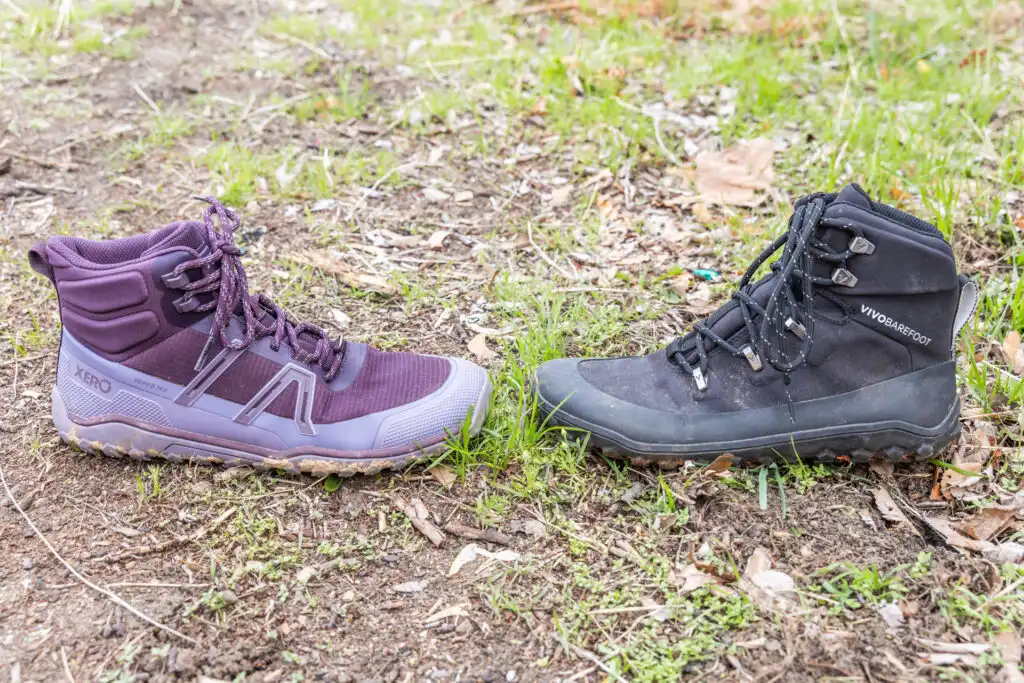
Barefoot hiking boots! We can’t get enough of them here at Terradrift. In fact, we’re at the point where we don’t hike in anything else. But not all barefoot boots are created equal. So we tested two pairs from some of our favorite brands to see how they compared in this Vivobarefoot vs Xero Shoes showdown: The Xero Scrambler Trail Mid WP and the Vivobarefoot Tracker Textile AT. And because we want you to find your perfect shoe the first time, we’re gonna break down how they’re different, where they excelled–or didn’t–and what type of hiker we think is gonna like each one best.
So let’s get to it, shall we?
If you’re new to barefoot shoes, go watch our video with tips on how to transition and check out some of our other barefoot shoe reviews, like our comparison of the non-waterproof versions of these Vivobarefoot vs Xero Shoes boots.

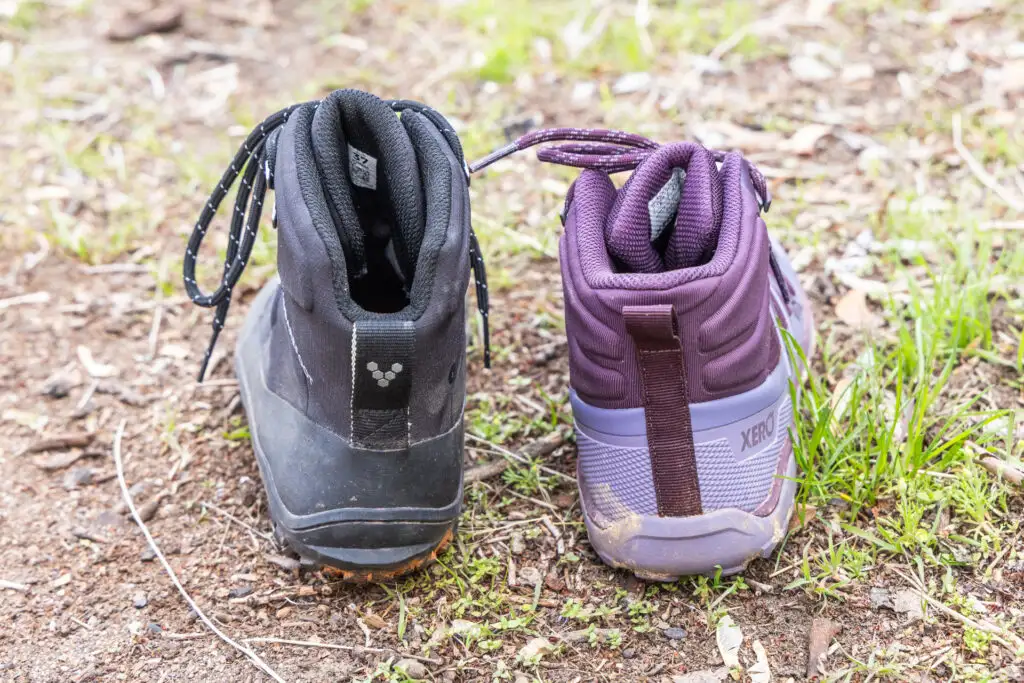
Vivobarefoot vs Xero Shoes: An Introduction and Note on Testing
Before we dive into discussing individual boots: both of these pairs are waterproof barefoot hiking boots. What are barefoot or minimalist hiking shoes? Basically, the term means they’re zero drop, have no arch support, have thin, flexible soles, wide toe boxes, and are designed to let your feet and ankles move naturally. They’re purpose-built for trails. Neither pair are specifically designed for winter hiking, but I did hike in them both in rainy and snowy conditions. So while they are suitable for cold conditions, below about freezing, neither kept my feet super warm if I stopped actively hiking (find more winter-appropriate barefoot boots here).
That makes them best suited for shoulder season temps and soggy seasons when it’s often wet AND cool (in my opinion). You can, of course, hike in them year-round, but these boots may be a bit stuffy for warm to hot days. But if you don’t mind, or your feet don’t tend to get as sweaty as mine, they can certainly function as year-round hikers. (When it gets hot, I’m switching to barefoot hiking sandals.)
Now on to the individual reviews and comparison!
Vivobarefoot Tracker Textile AT
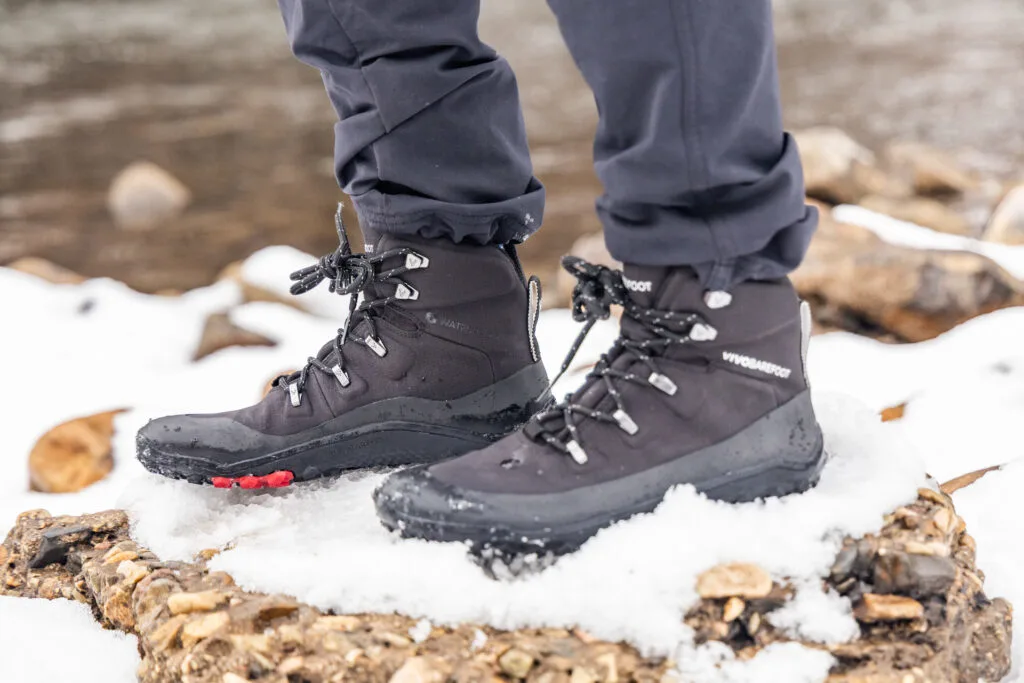
Frankly, I’ve always liked the look of Vivos more than many other barefoot shoes, and that goes for Vivobarefoot hiking boots, too. They’re sleek, they’re stylish, and the whole brand is not only super focused on the science and health of natural foot function, but also sustainability. And the new Tracker Textile AT is no exception. It looks serious but without being clunky and overbuilt (and is crafted with more sustainable materials).
Design
It’s designed with the same durable sole with aggressive tread as the brand’s other Tracker boots, but this one’s vegan. And more breathable than the leather options. Bonus: they come with a removable thermal liner that you can take in or leave out depending on the temperature and how much flexibility and ground feel you’re after (though it makes a negligible difference in that department).
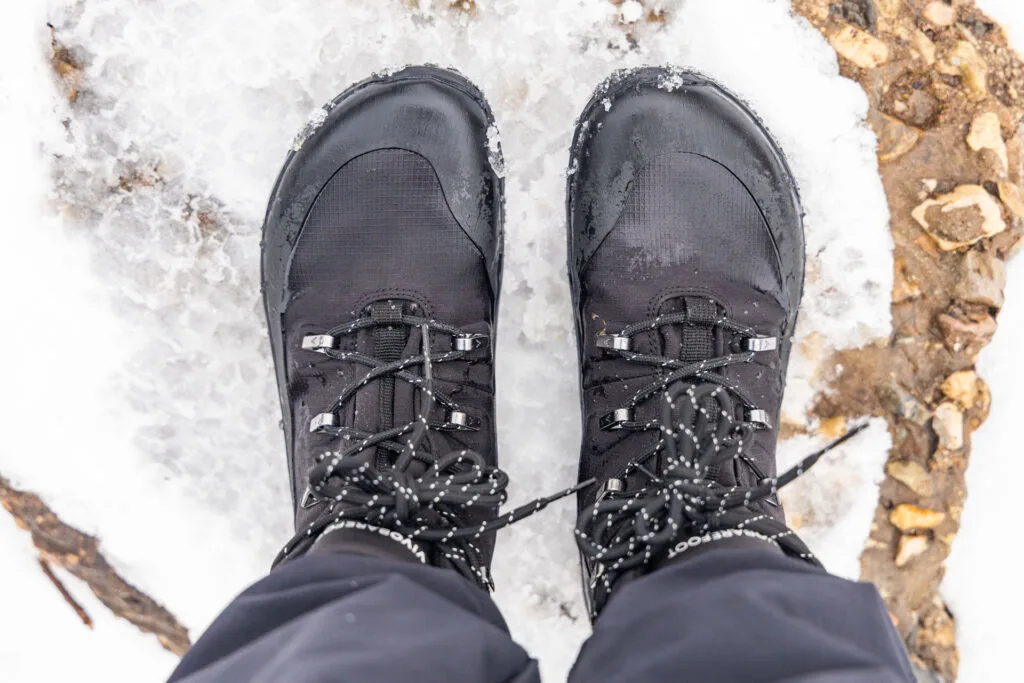
Comfort
Full disclosure: these will likely need some breaking in. The uppers were a little stiff right out of the box and the tongue created a few pressure points on my ankles on the first few hikes. With most other Vivos we’ve tested, that has faded with time as materials soften up, so that’s a plus, but it may take more than one trek, so give yourself adequate time to break them in.
The ankle padding is thin and flexible and moved with my ankle, which is important in order to preserve balance and optimum foot flexion and torsion. Fun fact: most healthy feet and ankles would do better without boots with ankle support. The heel cup is also stiff and on the narrow side, so I did feel a bit of pressure back there–kind of like a hard cage around my heel–that took some getting used to. It wasn’t painful, just odd-feeling at first.
Waterproofing
The high ankle and gusseted tongue did help keep out water. And while they weren’t the most breathable on warmer days–my socks were soggy with sweat after a long hike in sunny 55ºF temps–they never let in any water when walking through deep puddles, standing in creeks, or trekking through mud and slushy snow.
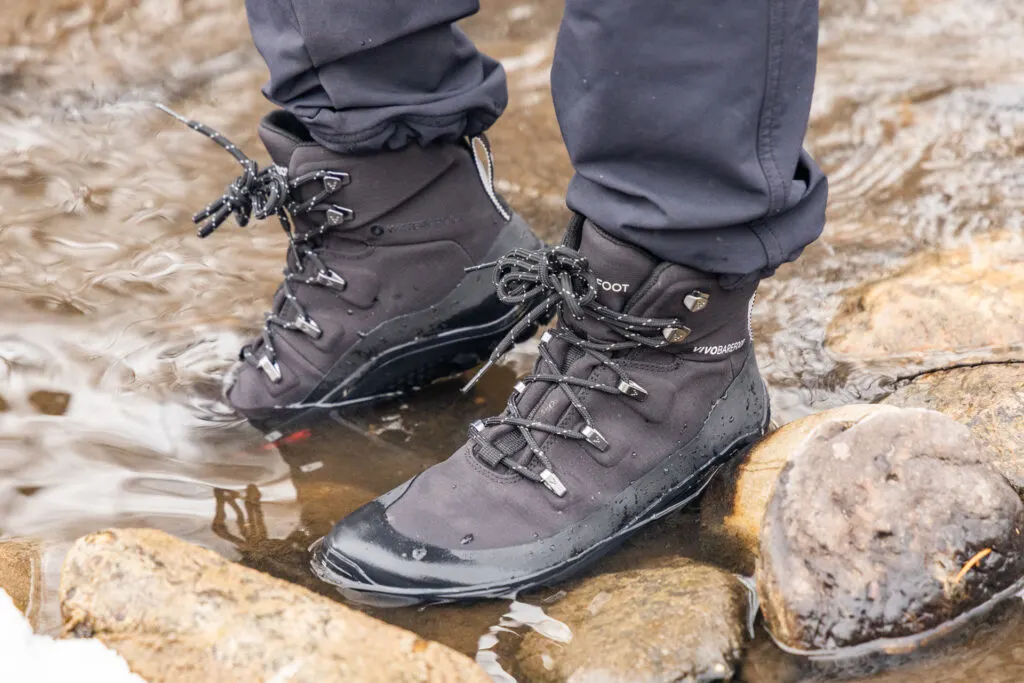
Groundfeel
The Tracker family of boots have a different groundfeel than some of our other favorite Vivo boots like the Magna Lite. While those are light, breathable, and ultra flexible, the Tracker Textile is designed to be more robust. Especially in the sole, which is less flexible than on most of the brand’s other footwear designs. On the upside, that denser sole means it’s also more protective. Which means if you don’t want to feel every single rock or deviation in the terrain, these may be a better fit for you.
I like to feel it all, so I found the soles a bit dense and inflexible. But that’s me. The traction was excellent, though on wet or dry surfaces.
Sizing + Options
The Tracker Textile is available in 4.5-11 for women and 7-15 for men, but with almost no half-sizes, so it may be trickier to find the right size for some folks. That said, if you’re familiar with Euro sizing, you shouldn’t have an issue. They’re narrower than the Xeros we tested. Just a touch, especially in the forefoot, but enough to notice.
This boot IS only available in one color for men and women: black. But I’m OK with that. If you’re only gonna have one shoe color, black is the way to go. And I do like the reflective stitching in the laces.
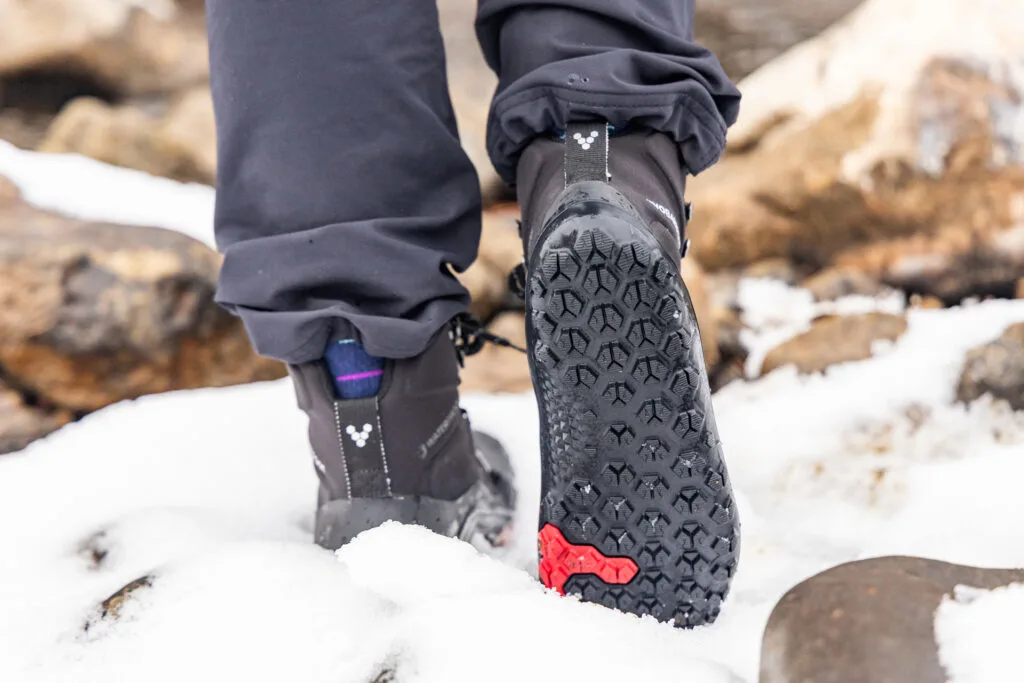
Price
On the downside, Vivobarefoot shoes are on the expensive side. The Tracker Textile AT is $220, so it’s not a budget buy. Fortunately, you can look for used or refurbished options on revivo.com. They’re still not gonna be cheap, but cheapER.
Sustainability
As for sustainability, the uppers and laces are made with almost entirely recycled materials, plus Vivo is a B-Corp, has a repair and resale platform, and is transparent with their mission and efforts, which we love.
Xero Shoes Scrambler Trail Mid WP
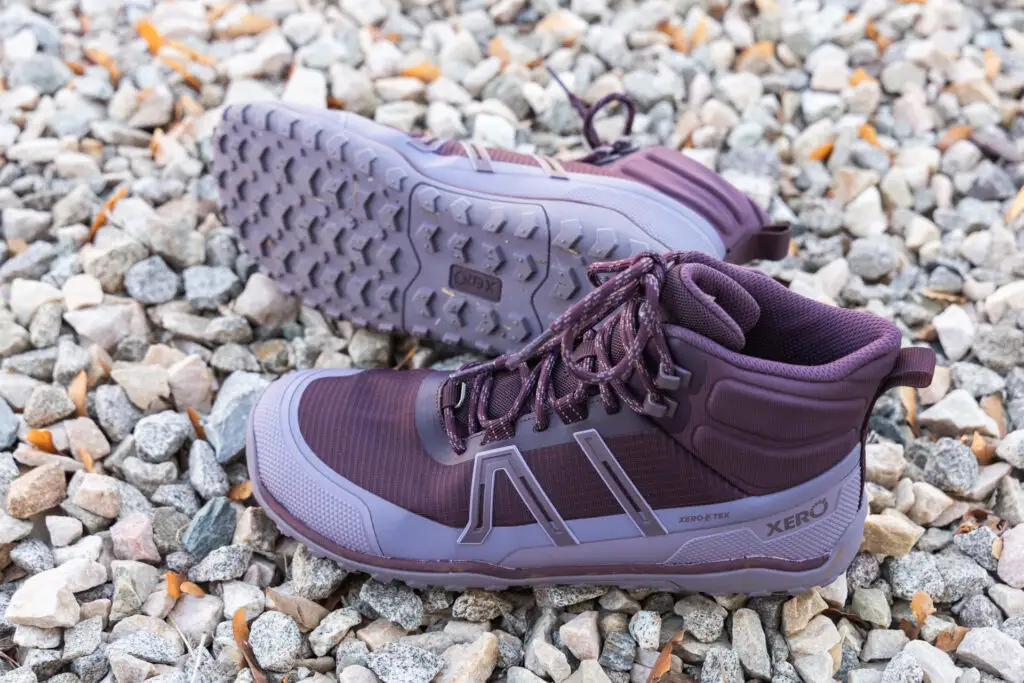
The Scrambler Trail Mid WP–”WP” stands for waterproof–is replacing the brand’s Xcursion Fusion. And in case you’re wondering, this one is available IN ADDITION TO the Scrambler Mid II WP we reviewed last year. What are the main differences between the ORIGINAL Scrambler MID II WP and the newer Scrambler Trail Mid WP? The new Scrambler Trail Mid is $30 cheaper and doesn’t have the eVent membrane or Michelin sole like the original. But what else makes it unique and how did it perform?
Design
The Scrambler Trail Mid WP uses Xero’s new XeroTex waterproof membrane and the soles are made with a different (less name-branded) compound. But honestly, I mostly couldn’t tell a difference between the original and new versions other than appearance (the new one looks more streamlined and sleek). And yes, I did go on a hike with one on each foot. There’s also a low-rise waterproof barefoot hiking shoe version and a non waterproof version, but the mid-rise option does help keep snow and water out, which is a plus. They may not look as minimalist and streetwear-ready as the Vivo Tracker, but they do have a more classic hiking boot look to them.
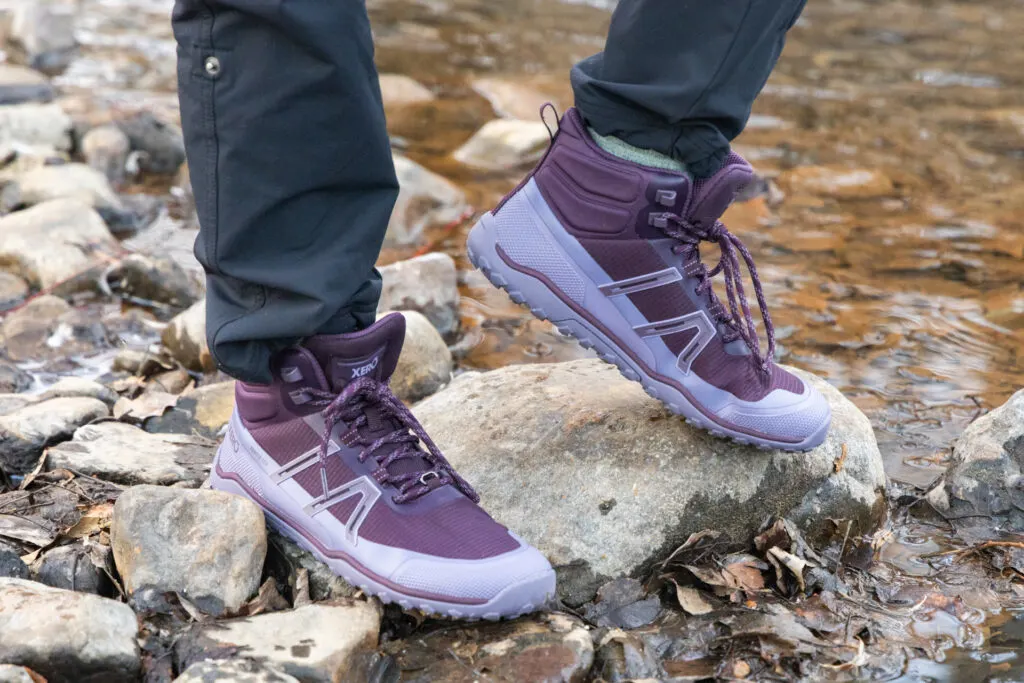
Comfort
Like pretty much all Xero Shoes we’ve tried, these are comfortable and basically require no break-in period. They’re soft and flexible right out of the box. The way I describe a lot of Xero hiking boots is it’s like putting on a really durable slipper: soft on the inside, flexible, no hard spots or rubbing. I like how Xero Shoes feel on my feet. Uppers were flexible and moved with me no matter what sort of terrain I was on and that ankle padding is soft and highly pliable, which offered maximum freedom of movement.
Waterpoofing
Xero’s XeroTex waterproofing seemed to work pretty dang well during testing, at least as well as the eVent membrane in the original design. I stood in creeks, hiked in sloppy snow and through puddles, and my feet stayed dry. How that membrane will stand up to longer term use is yet to be seen, but we’ll come back and update the post if there are any updates after a season or two of testing.
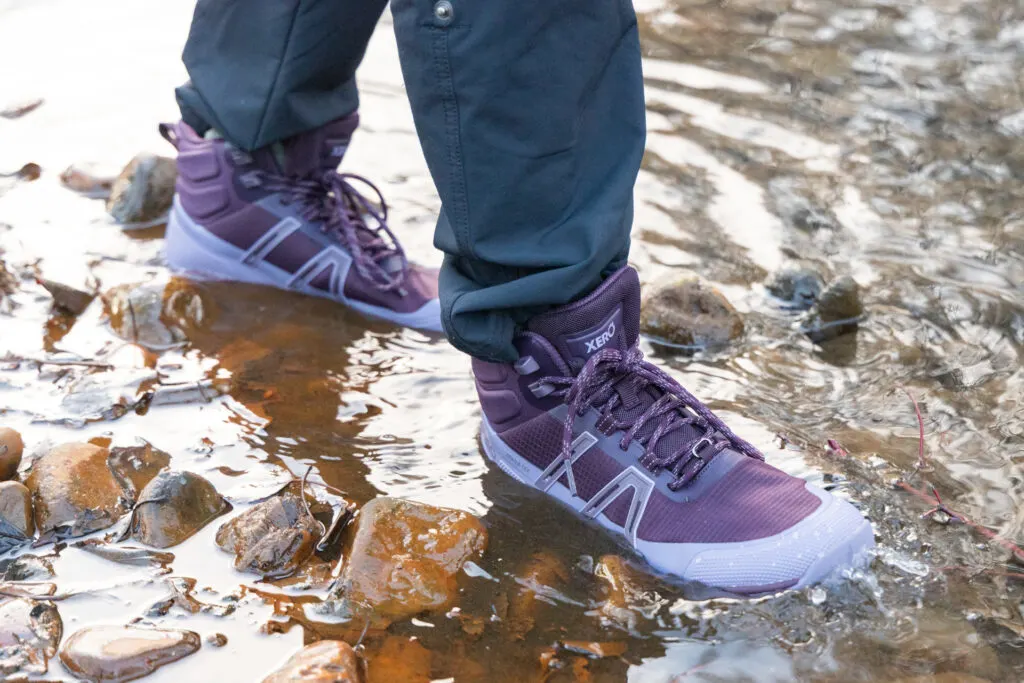
Groundfeel
The Scrambler Trail Mid offers solid flexibility and protection for the soles of your feet. The soles are more dense than some other Xero Shoes we’ve tested, like their sandals, trail runners or gym shoes, but still flex freely. Slightly more so than the soles of the Vivo Tracker Textile. Plus the soles were solid enough to keep me from feeling every little pebble underfoot, but offered a touch more groundfeel in comparison.
Sizing + Options
The shoes run pretty true to size. I usually wear an 8 in hiking boots to give my toes a bit more space on the downhill (read about how to find the right fit for your hiking boots) and that was perfect. For reference, in other Xero shoes, I wear smaller sizes: A 7 in sneakers or running shoes and a 6 in sandals. I have narrow feet, OK? That said, some folks have commented that these seem to run a bit on the narrow side, especially if you have high volume feet. They did feel like they were roomier than the Vivobarefoot boots, though.
They come in three colors for men and women–including neutrals–and a pretty wide range of sizes: 5-12 for women and 6.5-15 for men, including half sizes.
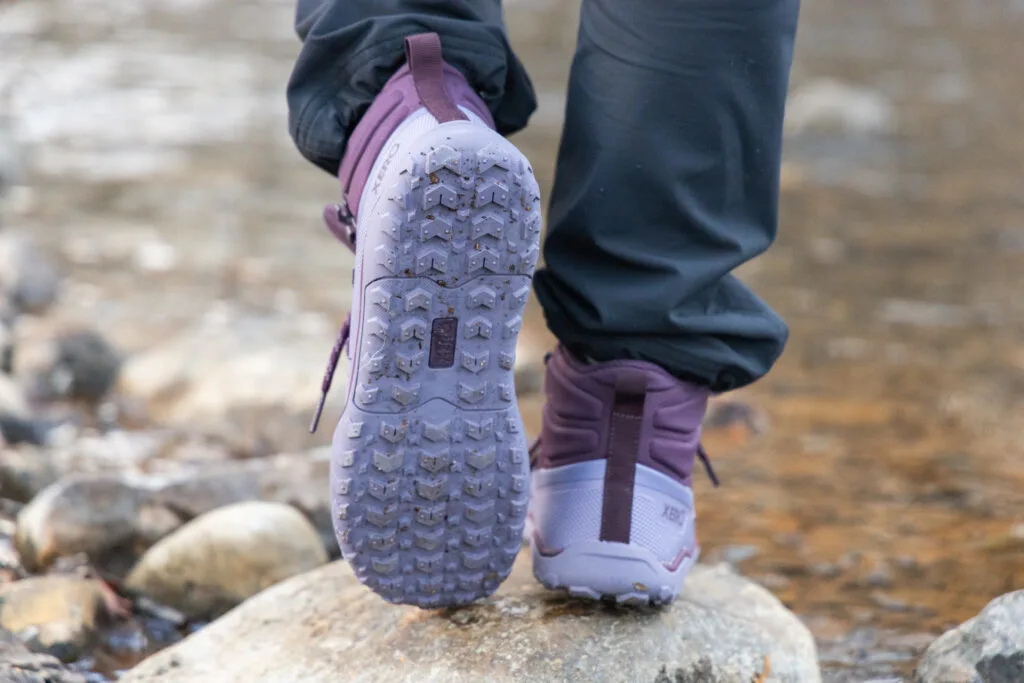
Price
The Scrambler Trail Mid is more reasonably priced barefoot hiking shoe at $160. You can also occasionally score a deal during periodic sales.
Sustainability
As for sustainability, Xero’s main focus is on making shoes that last. So they come with a 5000-mile sole warranty. Plus the brand supports the Tarahumara Children’s Hospital in Mexico and is transparent about their carbon emissions. The shoes are also PFAS-free and vegan.
Bottom Line: Vivobarefoot vs Xero Shoes

So now that you know the differences, the choice is up to you. Choose wisely, and let us know which ones you prefer and why. Or if you’ve tried them yourself and have anything to add! And if you’re looking for more waterproof barefoot boots, check out this post!
Then hit the trail this spring and wander on.
Do your current waterproof hiking boots need a refresh because they’re not shedding water like they used to? Learn how to clean your boots and refresh the waterproofing in this article.
